
Hornworms may seem harmless at first glance, but they can cause serious damage to your plants, especially tomatoes and peppers. Understanding how to spot them early can save your garden from becoming a buffet for these green giants. Let’s talk about what they look like, how to identify the signs of hornworms, and what you can do to keep your plants safe.
Understanding Hornworms: What Are They?
Hornworms are caterpillars that belong to the family Sphingidae. They can grow up to 4 inches long and are typically green, making them blend seamlessly with the foliage of plants. In the early stages of their life cycle, they’re small, but they can quickly turn into garden bullies.
You might be wondering why they’re called “hornworms.” Well, if you look closely, they have a distinct horn-like structure on their rear end, which gives them their name. There are two common types: the **Tomato Hornworm** and the **Tobacco Hornworm**. Both can wreak havoc, but they prefer different plants. Tomato hornworms are specifically drawn to tomatoes, while tobacco hornworms favor, you guessed it, tobacco plants.
Understanding their life cycle is just as important. These pests emerge from eggs laid by moths, often in late spring to early summer. If you’re not ready, they can lay waste to your garden in no time.
Signs of Hornworm Infestation
Identifying hornworms early can mean the difference between saving your plants and facing total destruction. So, how can you spot them? Here are some common signs:
- Chewed Leaves: If you notice chunks missing from your plants’ leaves, hornworms might be the culprits.
- Droppings: Look for small, dark droppings on leaves or the ground beneath your plants. This is a sure sign you have visitors.
- Silk Threads: Hornworms are known to suspend themselves from branches. You might find silk threads where they’ve taken a break.
It’s best to do a visual check of your plants every few days. Make it part of your gardening routine. If you catch them early, you can prevent a bigger problem down the road.
Tools and Techniques for Hornworm Prevention
So, how do you get ahead of hornworm season? There are several strategies and tools that can help keep these pests at bay. Here are a few tried-and-true methods:
- Physical Barriers: Consider using row covers or nets. These can create a barrier that prevents moths from laying eggs on your plants.
- Companion Planting: Some plants can repel hornworms. Try planting marigolds, basil, or other herbs among your vegetables.
- Pest Control Sprays: Organic options like neem oil or insecticidal soap can deter hornworms without harming your plants or beneficial insects.
Implementing these techniques early in the season is essential. Think of it like putting on sunscreen before heading to the beach—you’ll be much better off in the long run!
Handpicking Hornworms: A Simple Solution
If you spot hornworms on your plants, handpicking them is one of the most effective ways to deal with them. Yes, it might sound a bit gross, but it’s surprisingly effective.
Here’s how you can do it:
1. **Check Under Leaves:** Hornworms love to hide, so be sure to look under leaves and in-between branches.
2. **Wear Gloves:** This might make the process feel less icky. Plus, it offers some protection.
3. **Drop Them in a Bucket:** Once collected, drop them into a bucket filled with soapy water to ensure they can’t escape.
Honestly, getting rid of them this way is quite satisfying and can be quite a workout if you’re picking them off several plants!
Introducing Beneficial Insects
Another natural method for hornworm control involves introducing beneficial insects to your garden. This is a great way to balance the ecosystem without resorting to harmful chemicals.
Here are some insect friends to welcome into your garden:
- Ladybugs: Known for munching on aphids, ladybugs can help maintain a healthy garden environment.
- Braconid Wasps: These tiny wasps lay their eggs inside hornworms, effectively turning them into a host for the wasp larvae.
- Praying Mantises: They’ll eat just about anything, including hornworms, but be cautious about their impact on other garden insects.
Building a friendly garden community takes time, but it can yield great long-term benefits in pest control.
Monitoring Your Garden Regularly
Regular monitoring is key to keeping your garden healthy and hornworm-free. Set aside some time each week to inspect your plants. Here’s how you can make monitoring easier:
- Set a Schedule: Stick to a regular check-up schedule. Early mornings or evenings when temperatures are cooler often works best.
- Keep a Garden Journal: Document any signs of hornworms or other pests. Tracking these changes helps you plan your next steps.
- Involve Family or Friends: Make it a fun activity! Engaging others can help you spot things you might miss.
Remember, catching hornworms early can lighten your workload later. Prevention is far easier than dealing with an infestation.
Preparing for hornworm season might sound daunting, but it doesn’t have to be. With the right knowledge and strategies, you can protect your plants and keep your garden thriving. From handpicking to introducing beneficial insects, there are plenty of options to choose from.
Remember, being proactive is essential. Monitor your garden closely, educate yourself on hornworm signs, and implement protective measures early. This way, you can sit back, relax, and enjoy all the fruits of your labor, quite literally! Happy gardening!

